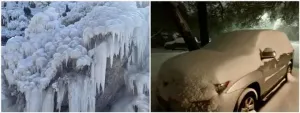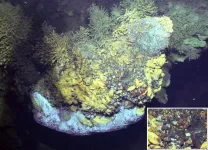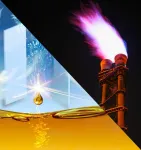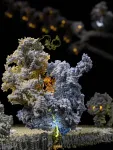(Press-News.org) EUGENE, Ore. -- Feb. 19, 2021 -- Friction caused by dry Martian dust particles making contact with each other may produce electrical discharge at the surface and in the planet's atmosphere, according University of Oregon researchers.
However, such sparks are likely to be small and pose little danger to future robotic or human missions to the red planet, they report in a paper published online and scheduled to appear in the March 15 print issue of the journal Icarus.
Viking landers in the 1970s and orbiters since then detected silts, clays, wind-blown bedforms and dust devils on Mars, raising questions about potential electrical activity.
Scientists have sought to determine experimentally if large electrical storms and lightning were possible and whether static electricity generated by particles of the planet's mostly basaltic rock striking vehicles or, eventually, visiting humans in protective gear would pose hazards.
Using volcanic ash as a stand-in for Martian dust, researchers in the lab of UO volcanologist Josef Dufek found that electrical discharges in Martian dust devils and storms are indeed possible. However, the discharges would likely be small given weak electrical fields, close to 20 thousand volts per meter, supported by the Martian atmosphere.
Earth's atmosphere, by comparison, can withstand electrical fields reaching 3 megavolts per meter, producing spectacular thunderous lightning storms common and sometimes deadly in the southeast United States, said Joshua Méndez Harper, a research engineer in the Oregon Center for Volcanology in the Department of Earth Sciences.
"Our experiments, and those of others before us, suggest that on Mars it is easy to get sparks when you agitate sand or dust," Méndez Harper said. "However, it may be difficult, even in large dust storms or within dust devils, to get very large discharges or conventional lightning because the Martian atmosphere is bad at storing charge."
Such anticipated triboelectric or frictional processes are experienced often on Earth by way of socks sliding across carpeting and then touching a doorknob or sticking a balloon on a window after rubbing it on human hair.
Martian dust devils, he said, may appear to sparkle, crackle or faintly glow as they roll across Mars' desiccated landscape but with discharges probably so small that they may not be visible except through detection of their radio waves.
Previous experiments to determine if spark discharges could occur were inconclusive because particles were swirled in a way that put them in contact with the walls of the testing enclosures. Some experiments used particles of materials not found on Mars. These contacts may have led to charging not characteristic of a Martian dust storm.
"We set out to determine whether the sparks observed in previous works were representative of Mars or merely experimental artifacts," Méndez Harper said.
At the UO, Méndez Harper, Dufek and George McDonald, a postdoctoral researcher at Rutgers University, got around the wall-exposure limitation using a vertical glass tube comparable in size to a water bottle measuring some 4 inches in diameter and 8 inches in length.
They created triboelectric charging by colliding particles of basaltic ash from Mexico's Xitle volcanic eruption about 2,000 years ago.
Collisions in the sealed tubes occurred at frictional velocities expected to occur during a light Martian breeze, without the particles touching the outer walls and in a pressurized, atmospheric pressure of 8 millibars of carbon dioxide, similar to that found on the Martin surface.
The Mexican basalt used in the project is similar to Martian basalt, as detected by rovers in the Pathfinder and Mars Exploration Rover missions and the dust analogs developed by NASA's Jet Propulsion Laboratory.
As a comparison, the research team conducted experiments in which the particles were allowed to make contact with surfaces foreign to anticipated conditions on Mars. Sparks occurred in both sets of experiments, but the addition of an artificial wall changed the polarity of the discharges.
"We were interested in pursuing this work because of the number of new missions to Mars and the potential of constraining observations," said Dufek, a professor in the Department of Earth Sciences and director of the Oregon Center for Volcanology. "Quantifying charging and discharging behavior has a bearing on the transport of dust in the atmosphere and has long been studied in relation to modulating chemical reactions, including synthesizing organic compounds."
NASA's Mars mission that landed Feb. 18 includes the Perseverance rover and Ingenuity robotic helicopter.
The low energy of discharge on Mars as indicated by the new experiments means these effects are unlikely to impact mechanical operations, Dufek said.
Nevertheless, Jezero crater, the landing site for Perseverance, seems to regularly experience dust storms in the autumn and winter. That, McDonald said, may provide opportunities for rudimentary observations of electrostatic phenomena.
One of the objectives of the Perseverance mission is to assess past environmental conditions. Evidence for a more substantial atmosphere in the past would have a bearing on the planet's electrical environment and how it has changed over time.
"The big takeaway from this study is that Mars may be an electrically active place, although in ways quite different than the Earth," Dufek said. "The fact that analog Mars dust readily charges up to the point of discharge even when grains did not rub against other surfaces suggests that future colonists may find a world modified by static electricity in subtle ways."
INFORMATION:
The National Science Foundation funded the research through a grant to Dufek. Méndez Harper was supported by a Blue Waters Graduate Fellowship.
Links:
About Josef Dufek: https://pages.uoregon.edu/jdufek/
Department of Earth Sciences: https://earthsciences.uoregon.edu/
Oregon Center for Volcanology: https://pages.uoregon.edu/volcanologycenter/
About Blue Waters: https://bluewaters.ncsa.illinois.edu/blue-waters-overview
China is just one of many countries in the Northern Hemisphere having what researchers are calling an "extremely cold winter," due in part to both the tropical Pacific and the Arctic, according to an analysis of temperatures from Dec. 1, 2020, to mid-January of 2021. A country-specific case study, the investigation potentially has far-reaching implications for predictions and early warnings to protect against harmful impacts, researchers said.
The results were published online, ahead of print, on Feb. 12 in Advances in Atmospheric Sciences.
"We are trying to explain why the countries in the Northern Hemisphere ...
Nanoparticles used in drug delivery systems, bioimaging, and regenerative medicine migrate from tissues to lymphatic vessels after entering the body, so it is necessary to clarify the interaction between nanoparticles and lymphatic vessels. Although technology to observe the flow of nanoparticles through lymphatic vessels in vivo has been developed, there has been no method to evaluate the flow of nanoparticles in a more detailed and quantitative manner ex vivo. Thus, research was conducted to develop an ex vivo lymphatic vessel lumen perfusion system to determine how nanoparticles move in lymphatic vessels and how they affect the physiological movement of lymphatic vessels.
Nanoparticles introduced into the ...
A research team led by Prof. QIAN Peiyuan, Head and Chair Professor from the Hong Kong University of Science and Technology (HKUST)'s Department of Ocean Science and David von Hansemann Professor of Science, has published their cutting-edge findings of symbiotic mechanisms of a deep-sea vent snail (Gigantopelta aegis) in the scientific journal Nature Communications. They discovered that Gigantopelta snail houses both sulfur-oxidizing bacteria and methane-oxidizing bacteria inside its esophageal gland cells (part of digestive system) as endosymbionts. By decoding the ...
A new study looking at how COVID-19 affects people with asthma provides reassurance that having the condition doesn't increase the risk of severe illness or death from the virus.
George Institute for Global Health researchers in Australia analysed data from 57 studies with an overall sample size of 587,280. Almost 350,000 people in the pool had been infected with COVID-19 from Asia, Europe, and North and South America and found they had similar proportions of asthma to the general population.
The results, published in the peer-reviewed END ...
Researchers at the University of Illinois Chicago have discovered a way to convert the methane in natural gas into liquid methanol at room temperature.
This discovery, reported in the journal Proceedings of the National Academy of Sciences, could potentially provide a cleaner energy source for many of our everyday activities.
When burned, natural gas -- the fuel used to heat homes, cook food and generate electricity -- produces carbon dioxide, a powerful greenhouse gas.
According to the U.S. Energy Information Administration, the U.S. consumed approximately 31 trillion cubic feet of natural gas in 2019, contributing roughly 1.6 gigatons of carbon dioxide to the atmosphere.
A better way to use natural gas would be to convert it to methanol, a liquid fuel that burns more ...
University of Queensland scientists have developed an ultraviolet 'television' display designed to help researchers better understand how animals see the world.
Until now, standard monitors on devices like televisions or computer screens have been used to display visual stimuli in animal vision studies, but none have been able to test ultraviolet vision - the ability to see wavelengths of light shorter than 400 nanometres.
Dr Samuel Powell, from the Queensland Brain Institute's Marshall lab, said this new technology will help unveil the secrets of sight in all sorts of animals, such as fish, birds and insects.
"Human TVs generally use three colours - red, green and blue - to create images, but our newly-developed ...
Mitochondria are organelles that act as the powerhouses in our body. They use oxygen which we inhale and food we eat to produce energy that supports our life. This molecular activity is performed by bioenergetic nano-factories incorporated in specialized mitochondrial membranes. The nano-factories consist of proteins cooperatively transporting ions and electrons to generate chemical energy. Those have to be constantly maintained, replaced and duplicated during cell division. To address this, mitochondria have their own bioenergy protein-making machine called the mitoribosome. Given its key role, a deregulation of the mitoribosome can lead to medical disorders such as deafness and diseases including cancer development. The first fundamental understanding of how mitoribosomes ...
A POSTECH-KAIST joint research team has successfully developed a technique to reach near-unity efficiency of SHEL by using an artificially-designed metasurface.
Professor Junsuk Rho of POSTECH's departments of mechanical engineering and chemical engineering, and Ph.D. candidate Minkyung Kim and Dr. Dasol Lee of Department of Mechanical Engineering in collaboration with Professor Bumki Min and Hyukjoon Cho of the Department of Mechanical Engineering at KAIST have together proposed a technique to enhance the SHEL with near 100% efficiency using an anisotropic metasurface. For this, the joint research team designed a metasurface that transmits most ...
Photo and map
Robotic laboratories on the bottom of Lake Erie have revealed that the muddy sediments there release nearly as much of the nutrient phosphorus into the surrounding waters as enters the lake's central basin each year from rivers and their tributaries.
Excessive phosphorus, largely from agricultural sources, contributes to the annual summer cyanobacteria bloom that plagues Lake Erie's western basin and the central basin's annual "dead zone," an oxygen-starved region that blankets several thousand square miles of lake bottom and that reduces habitat for fish and other organisms.
The release of phosphorus from Lake Erie sediments during periods of low oxygen--a phenomenon known as self-fertilization or internal loading--has been acknowledged since the 1970s. ...
We are most familiar with the four conventional phases of matter: solid, liquid, gas, and plasma. Changes between two phases, known as phase transitions, are marked by abrupt changes in material properties such as density. In recent decades a wide body of physics research has been devoted to discovering new unconventional phases of matter, which typically emerge at ultra-low temperatures or in specially-structured materials. Exotic "topological" phases exhibit properties that can only change in a quantized (step-wise) manner, making them intrinsically robust against impurities and defects.
In addition to topological ...




